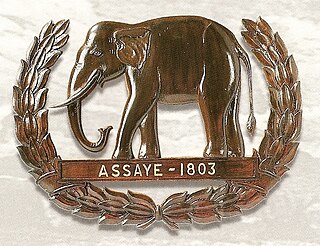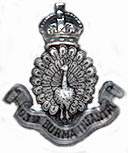Related Research Articles

The 1st Punjab Regiment was an infantry regiment of the British Indian Army from 1922 to 1947. Upon the Partition of India, it was transferred to the newly-raised Pakistan Army. It ceased to exist in this form in 1956, when it was amalgamated with the 14th, 15th and 16th Punjab regiments to form the Punjab Regiment, an existing infantry regiment of the Pakistan Army.

A pioneer is a soldier employed to perform engineering and construction tasks. The term is in principle similar to sapper or combat engineer. Pioneers were originally part of the artillery branch of European armies. Subsequently, they formed part of the engineering branch, the logistic branch, part of the infantry, or even comprised a branch in their own right.

The Assaye battle honour was awarded by the Governor General of British India to all East India Company battalions and British Army regiments that took part of the Battle of Assaye. The battle occurred on 23 September 1803, near the village of Assaye in western India where a small force under the command of Major General Arthur Wellesley defeated a 50,000 strong army of the Maratha Confederacy. The British and native troops were awarded the battle honour Assaye with the device of Elephant vide General Order of Governor General dated 30 October 1803. The British regiments and Madras battalions involved were also presented with an honorary colour to mark their achievement. The Madras Battalions celebrated the victory for over a century till their disbandment in the 1920s.

The 62nd Punjabis was an infantry regiment of the British Indian Army. It was raised in 1759 as the 3rd Battalion of Coast Sepoys, and formed part of the Madras Army. It was designated as the 62nd Punjabis in 1903 and became 1st Battalion 1st Punjab Regiment in 1922. In 1947, it was allocated to the Pakistan Army, where it continues to exist as 1st battalion, Punjab Regiment. It is the senior-most surviving infantry battalion of the British Indian Army.

The 66th Punjabis was an infantry regiment of the British Indian Army. It was raised in 1761 as the 7th Battalion of Coast Sepoys. It was designated as the 66th Punjabis in 1903 and became 2nd Battalion 1st Punjab Regiment in 1922. In 1947, it was allocated to the Pakistan Army, where it continues to exist as 2nd Battalion The Punjab Regiment.

The 76th Punjabis was an infantry regiment of the British Indian Army. It was raised by Captain Thomas Lane at Trichonopoly on 16 December 1776, as the 16th Carnatic Battalion. It was designated as the 76th Punjabis in 1903 and became the 3rd Battalion 1st Punjab Regiment in 1922. In 1947, it was allocated to the Pakistan Army, where it continues to exist as 3rd Battalion The Punjab Regiment.

The 82nd Punjabis was an infantry regiment of the British Indian Army. It was raised in 1788, as the 29th Madras Battalion. It was designated as the 82nd Punjabis in 1903 and became the 5th Battalion 1st Punjab Regiment in 1922. In 1947, it was allocated to the Pakistan Army, where it continues to exist as 4th Battalion The Punjab Regiment.

The 84th Punjabis was an infantry regiment of the British Indian Army. It was raised by Captain Donald Macdonald at Vellore on 12 August 1794, as the 34th Battalion of Madras Native Infantry. It was designated as the 84th Punjabis in 1903 and became the 10th (Training) Battalion, 1st Punjab Regiment in 1922. In 1943, it was converted into the 1st Punjab Regimental Centre. In 1947, the 1st Punjab Regiment was allocated to the Pakistan Army. In 1956, the 1st, 14th, 15th and 16th Punjab Regimental Centres where amalgamated to form the Punjab Regimental Centre.

The 89th Punjabis was an infantry regiment of the British Indian Army raised in 1798 as a battalion of Madras Native Infantry. It was designated as the 89th Punjabis in 1903 and became 1st Battalion 8th Punjab Regiment in 1922. In 1947, it was allocated to Pakistan Army, where it continues to exist as 1st Battalion, The Baloch Regiment.

The 90th Punjabis were an infantry regiment of the British Indian Army. The regiment was raised in 1799 as a battalion of Madras Native Infantry. It was designated as the 90th Punjabis in 1903 and became 2nd Battalion 8th Punjab Regiment in 1922. In 1947, it was allocated to Pakistan Army, where it continues to exist as 2nd Battalion of The Baloch Regiment.

The 93rd Burma Infantry was an infantry regiment of the British Indian Army. The regiment was raised in 1800 as a battalion of Madras Native Infantry. It was designated as the 93rd Burma Infantry in 1903 and became the 5th (Burma) Battalion 8th Punjab Regiment in 1922. In 1947, it was allocated to the Pakistan Army, where it continues to exist as 5th Battalion of The Baloch Regiment.
The 64th Pioneers was a regiment of the British Indian Army. Originally serving as regular infantry it evolved into a specialist military pioneer unit performing engineering and construction tasks.
The 2nd Bombay Pioneers was a regiment of the British Indian Army. The regiment was formed in 1922, when the infantry of the Indian Army moved from single battalion to multi battalion regiments. They were renamed The Corps of Bombay Pioneers in 1929, and were disbanded for reasons of economy in 1933.

The 61st Pioneers were an infantry regiment of the British Indian Army. They trace their origins to 1758, when they were raised as the 1st Battalion Coast Sepoys.
The 67th Punjabis were an infantry regiment of the British Indian Army. They could trace their origins to 1759, when they were raised as the 8th Battalion Coast Sepoys.

The 73rd Carnatic Infantry was an infantry regiment originally raised in 1776 as the 13th Carnatic Battalion as part of the Presidency of Madras Army which was itself part of the Honourable East India Company Army. The presidency armies, like the presidencies themselves, belonged to the East India Company until the Government of India Act 1858 transferred all three presidencies to the direct authority of the British Crown. In 1903 all three presidency armies were merged into the British Indian Army. The unit was transferred to the Indian Army upon Indian Independence.
The 81st Pioneers were an infantry regiment of the British Indian Army. They could trace their origins to 1786, when they were raised as the 28th Madras Battalion.

The 4th Hazara Pioneers was a regiment of the British Indian Army formed in 1922, when the Indian army moved from single battalion regiments to multi-battalion regiments; the 106th Hazara Pioneers became the 1st Battalion 4th Hazara Pioneers. The 4th Hazara Pioneers were one of four Pioneer units in the 1922 reorganisation, including the 1st Madras Pioneers, 2nd Bombay Pioneers, and 3rd Sikh Pioneers.